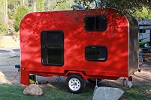[quote="noseoil"]A router is really a great tool to have & use. If you decide to get one, do some practice passes first, so you aren't butchering your panels or making mistakes on the finished work. Carbide cutters are a must, high speed steel won't last.
Thanks Noseoil, i am thinking more about getting a router. My hesitation has less to do with the expense, than with worrying about hacking things up. Something along the lines of a cleat seems more inline with the skills I have.
I appreciate this and all the advice you all have offered, it is really helpful and this would be a much more difficult project with out it!
First build 5x10 Rimple design
Re: First build 5x10 Rimple design
continuing work on the walls. To improve the sidewall curves, and better assure both sidewalls have the same curve, i laid the two walls on top of each other, clamped them and sanded them.
It is still not an exact perfect curve but is much, much better than after my first cut/sand.
I also took a practice cut using a utility knife on the 3mm baltic birch interior skin. it is very bendy, so i don't want to use the jigsaw on it. The utility knife worked great, and after about 10 passes with good amount of pressure it cut through...no chipping, nice straight line. so i will proceed with using the utility knife to make the interior skin cuts.
KC thanks for advice on both of these things!
It is still not an exact perfect curve but is much, much better than after my first cut/sand.
I also took a practice cut using a utility knife on the 3mm baltic birch interior skin. it is very bendy, so i don't want to use the jigsaw on it. The utility knife worked great, and after about 10 passes with good amount of pressure it cut through...no chipping, nice straight line. so i will proceed with using the utility knife to make the interior skin cuts.
KC thanks for advice on both of these things!
-

mariannf - Teardrop Master
- Posts: 193
- Joined: Wed Oct 28, 2015 3:13 am






 Can't count the number of times I have used them on my build, it's too many.
Can't count the number of times I have used them on my build, it's too many. Oh, KC, you write so eloquently! And, you're correct, too!
Oh, KC, you write so eloquently! And, you're correct, too!